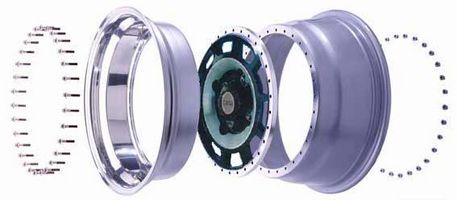Whether or not you are the techie type, at the time of changing your alloys, you might have wondered about :
Wheels can be products of exquisite beauty as car tuning afficionados are well aware. But the general public knows very little about the manufacturing processes involved, and what are the different elements that compose the wheel too. Wheels can be : One-piece wheels (the most widespread category), or composed of several parts, in which case they are referred as Multi-piece wheels : The hub, the spokes and the rim.
The multi-peice wheels is composed of several ( 2-3) pieces that are welded together to be used as a wheel.

Multi-piece wheels are manufactured following several different methods. The central hub is either forged or cast. The rim of three part wheels is often made out of aluminium but may include magnesium too
Multi-piece wheels are very flexible. The method enables the manufacturing of custom made wheels originally very popular in the racing industry, with the general public only catching up later.
Multi piece wheels are generally present on the high end range of the market, they allow for a wide range of applications and are loved by people driving custom-made cars with rare sizes requirements. In case one part of the wheel breaks, it is possible to replace only the part that failed .
The manufacturing of one-piece wheels is done by casting molten aluminium into a mould. Even though this sounds simple, Being able to produce good quality, reliable wheels require exceptional craftsmanship.
Gravity casting is the simplest method to obtain wheels, just relying on the phenomenon of gravity.
The main asset of gravity casting is its comparatively low cost. It is also an interesting option when design ranks higher in the priority list than weight.
Given that this method relies entirely on gravity, the density of aluminium is not as high as when using other type of production methods.
Most of the time, those type of wheels require more mass in order to meet the safety requirements..
Low pressure casting uses low pressure to accelerate the process compared to gravity casting alone. As a result, the mechanical properties of the wheel are of better quality than for gravity alone. .
The production cost of low pressure casting is slighlty higher than for gravity casting. The extra cost alone didn't prevent low pressure casting from becoming the standard production method for cast alloys
Some manufacturers increase the pressure to obtain higher density materials. Increasing the pressure involve higher costs.
The low pressure cast alloy wheel is the number one choice in the replacement market for striking a good balance between resistance and weight
This cutting edge method is based on a low pressure casting. The second step involves a dedicated machine that stretches the alloy into its final shape using steel rollers that apply high pressure and heat the the rim area. The whole process is somehow similar to a potter's wheel
Combined together, rotation pressure and heat allow to produce rims with similar resistance to forged wheels and to cut down the production cost.
O.Z has used this technology for years, for the production of formula1 wheels.
The High Light technology wheels by OZ for formula 1 is the best example of flow forming wheels
Basically, all manufacturers are trying to replicate the huge material quality of forged wheels without paying the high cost involved in forging.
They are on the high end of the market
Forging consists in beating a lump of aluminium into the desired shape, in this case, a wheel.
The end product is so dense and resistant that forged wheels are very light
The costs in terms of tooling, and other investment is so high that it turnes forged alloys into luxury products.
As we mentioned earlier on, the manufacturing methods for multi-piece wheels doesn't substantially differ from the other categories.
It above all makes it easier to combine several materials together, for example, magnisium for the hub and aluminium alloy for the remaining part......
Wheels